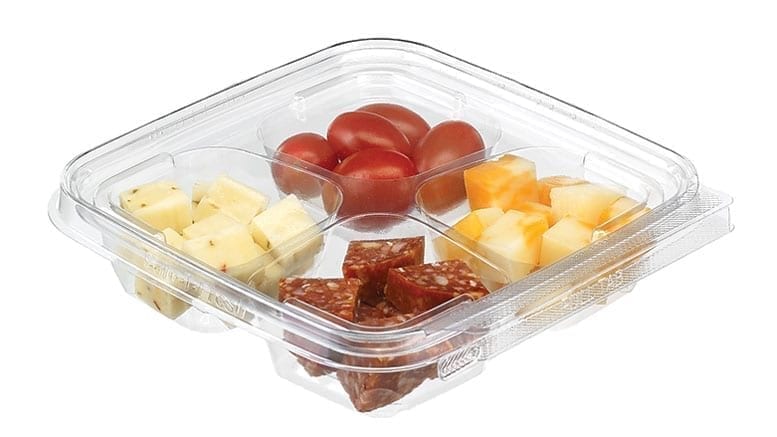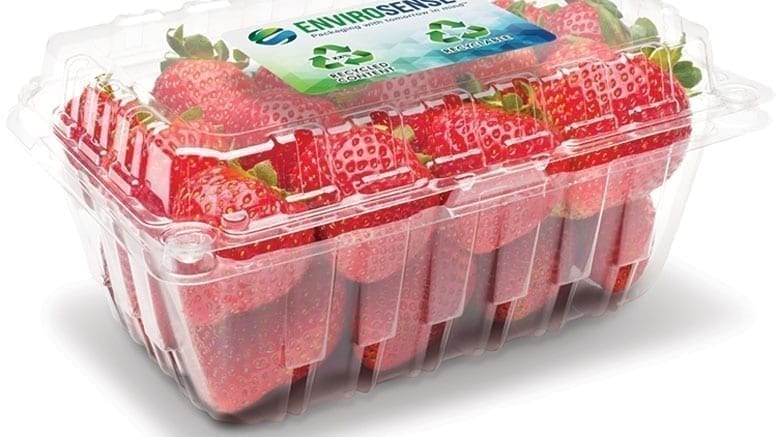Originally printed in the January 2020 issue of Produce Business.
Steady growth and variety of options keep this trend hot.
There’s nothing like the eye-appeal, buy-appeal of a produce department that looks like a just-picked farm stand. Many customers like to see, feel, smell and even taste samples from bulk displays of fresh fruits and vegetables before making a purchase.
Yet, packaged produce has grown to 53% of total sales, spurred by more organic and value-added produce as well as Millennial shoppers who prefer packaged rather than pick-your-own fresh fruits and vegetables, according to The Power of Produce report, published by the Arlington, VA-headquartered Food Marketing Institute (FMI) in 2019.
More specifically, demand for clamshell packaging is projected to increase 6.3% annually to nearly $1.1 billion in 2022, with unit demand anticipated to advance 4.3% each year to almost 5.8 billion in the same time frame, according to the June 2018-published report, Produce Packaging — Trends, Demand and Forecasts, by The Freedonia Group, a Cleveland-headquartered division of MarketResearch.com.
“Berries, like strawberries and raspberries, are probably now exclusively packed in clamshells,” says Isaiah Arndt, director of produce and floral merchandising for the 70 independent grocers that are part of Tukwila, WA-based Northwest Grocers, which operates under banners such as Thriftway, Payless Foods, Red Apple Markets and IGA Markets.
“Grapes are another good one that sell well in clamshells. More recently, we’ve seen plums, apricots and kumquats, which previously we sold loose, packed in clamshells. We also carry a line of organic value-added salads in clamshells. This works well for us because our stores have transitioned to a spring load shelf system, and we can merchandise the salads in upright placed facings.”
The percent compound annual growth in demand for clamshell packaging based on application is 7.5% for salads, 6.7% fruit, 6.6% berries, 5.2% vegetables and 4.9% tomatoes, according to the Freedonia report.
DEFINED & REFINED
Traditionally, clamshells are defined as a single-piece thermoformed container where the lid and base cavity are connected by a thin hinge, says Andy Liable, marketing manager for Sonoco, in Hartsville, SC. “In the produce industry, you may sometimes extend that definition to include 2-piece structures that combine a separate rigid lid that fits on a rigid base tray.”

Since their introduction, says Liable, clamshells have proven to be an extremely effective packaging solution that meets many of the criteria that growers, retailers and consumers are looking for. Some of the most important attributes provided are product protection, adequate cooling, transparency, cube utilization, easy open and recloseability, stackability and ease of storage.
While not technically defined as a clamshell, one of the biggest changes over the past couple of years has been the adoption of topseal trays or bowls with flexible lidding.
“Some of our customers, grape tomato growers for example, are converting to this type of packaging. It’s a big trend. The thought is that it lowers the eco-footprint by reducing plastic weight by 20% or more,” says Niall Kelly, vice president and general manager of the Bunzl Agriculture Group, an Oxnard, CA-based family of agriculture supply companies including Cool-Pak, Destiny Packaging, Netpak and the Monte Package Company.
WHAT WORKS, WHAT’S NEW
A properly designed produce clamshell should close well, protect, be right sized and shaped, assist in merchandising and be eco-friendly.
CLOSURE. “What I look for most in clamshell packaging is that it stays sealed. I don’t want it to pop open and create a hazard in the store or an inconvenience for shoppers on the way or at home,” says Randy Bohaty, produce director for B&R Stores, an 18-location chain based in Lincoln, NE, which operates under the Russ’s Markets, Super Saver, Apple Market and Save Best Foods banners.
“Secure closures and tamper evident features are of interest especially in cut/processed produce products,” says Adrianne Tipton, senior vice president of innovation for Novolex, in Hartsville, SC.

PROTECTION. Clamshell containers, specifically, offer an added layer of protection for fruits and vegetables that easily bruise, keeping the produce fresher and more appealing, says Cindy Blish, associate brand and communication manager for Inline Plastics Corp., in Shelton, CT. “These features allow for longer shelf-life, and therefore less waste.”
This packaging type is also highly effective in protecting small piece items such as berries, grape tomatoes, grapes, or cherries, according to Sonoco’s Liable.
“It’s important that the clamshells are strong enough to bear the weight of the product during shipment,” says B&R Stores’ Bohaty.
Key questions to determine what type of clamshell packaging is most appropriate, according to Inline Plastics’ Blish, include: What type of produce is going in the clamshell? How heavy is the product? And, how robust the container needs to be both for managing weightier product and to support shipping and stacking on a shelf.
“Some of the latest and newest designs are sturdy enough to handle and enable retailers to double and triple stack the product on display in-store,” says Kurt Zuhlke, president of Kurt Zuhlke & Associates Inc., in Bangor, PA.
SHAPES & SIZES. A benefit of packaging is selling a particular amount of, and possibly even more, produce. In particular, says Northwest Grocers’ Arndt, “we’ve seen a move from 4- to 6-ounce and 1- to 2-pound clamshells for berries.”

Every category has standard sizes that contribute the biggest volume (1-pound strawberries, for example), according to Sonoco’s Liable. However, “the continued success of warehouse club stores also offers the opportunity to introduce larger pack sizes across different fruits or vegetables. For example, 3-pound grapes.”
Smaller, meaning snack-size and/or single-serve, package sizes are also growing in popularity. In fact, the FMI’s Power of Produce report reveals that four in 10 of those surveyed seek convenience snack options and that 97% of American households are trying to eat more fresh produce.
“Our latest introduction to the marketplace is our SnackWare containers. These multi-compartment packages allow retailers to mix-and-match fruits, veggies, nuts and seeds, along with dips and sauces. Mixing and matching cut produce is a growing trend as it allows consumers to grab-and-go these convenient, ready-to-eat healthy snacks. It also allows greater merchandising opportunities with the placement of produce branding and information on the container,” explains Inline Plastics Corp.’s Blish.
EYE-CATCHING. “Clarity or shopper’s ability to see the product inside is an important attribute I look for. Also, that the package presents the product well on the shelf. Merchandising is a key element of good packaging,” says B&R Stores’ Bohaty.
Impulse sales increase with the attractive and convenient packaging a clamshell offers, according to Blish. “Consumers will respond to container clarity. They want the food to be visible so they can be sure the product they are buying is fresh.”
Unique designs with decorative vents and distinctive labeling have been an increasing trend in clamshells, says Novolex’s Tipton. “This also denotes a higher end product inside and affords a higher price point.”
Indeed, clamshells are often used to show off more specialty type produce.
“Asian pears, for example. We’ve recently worked on a 3-pack clamshell of this fruit for a customer,” says Kurt Zuhlke & Associates’ Zuhlke.
Grape or cherry tomatoes, such as those of a proprietary variety, greenhouse grown or assorted colors, are another good example of premium produce packed in clamshells designed to show off the product inside.
“Differentiation on the store shelves, how you call attention to the display, educating the consumer about the pack style, brand, and story of the grower are all key points to any produce packaging clamshell or other,” says Sara Lozano, marketing manager for Sambrailo Packaging, in Watsonville, CA.
Eye-catching evolutions in designs are a necessity, according to the Bunzl Agriculture Group’s Kelly. “Hot house tomatoes are on the front end of this, and there’s no stopping them. For blueberries, there hasn’t been much change. If you don’t change, others will, and you’ll be yesterday’s news. The key is that you want your product to stand out on the shelf.”
ECO-FRIENDLY. Nearly half (42%) of consumers say products that have packaging made from recycled and/or sustainable materials are important to their day-to-day shopping, according to Sustainable Packaging Unwrapped, a 2019-published survey of U.S. and U.K. consumers by London, UK-based market research firm, Globalwebindex. What’s more, the percent of shoppers globally who say they are willing to pay more for eco-friendly packaging has grown from 47% to 59% in the past seven years.
“The largest driver in the packaging market by far, and a top in every conversation from the shipper to retail level, is sustainable packaging,” says Bunzl Agriculture Group’s Kelly.
At Inline Plastics, all containers are 100% recyclable, according to Blish. “We use the highest quality PET, and about 15 percent of our raw materials come from rDPET (recycled degraded PET), which is post-industrial recycled DPET (degraded PET). The use of rDPET has a 28% lower carbon footprint.
In October, Bunzl introduced its new line of earth-friendly packaging, including a wash off label.
“Customers have asked for a way to separate their traditional recycled PET (polyethylene terephthalate) containers, such as clamshells, from the traditional paper and BOPP (biaxially-oriented polypropylene) labels so they can be recycled. We have several adhesive options that allow labels to be washed off in a PET Recycling stream or removed from the container to enable the PET container to be recycled again,” explains Kelly.
Labels are one aspect of the comprehensive recommendations laid out in the APR Design Guide for Plastic Recyclability, published in 2018 by the Washington, DC-headquartered Association of Plastic Recyclers (APR). The document is billed as providing the method needed to close the gaps between package designers and plastic recyclers to create a complete circular economy for this material and is one of the biggest initiatives to affect clamshells in recent years. Other aspects of plastic packaging covered in this text include the base polymer of which the pack is created; barrier layers, coatings and additives used; dimensions; closures and dispensers; and attachments.
“Across the produce sector overall, expect to see 30% to 50% APR adoption by 2020, with the balance occurring in 2021 and 2022. My suggestion to produce executives is to stick your toe in the water by planning to convert at last 10% of your packaging now. To do this, educate yourself on what is available, and ask the right questions of suppliers regarding materials and footprint. You might be surprised. There’s a good chance this change is actually better than what you have now and for only a slightly higher cost that should be absorbable,” says Bunzl’s Kelly.
A second major eco-sustainable packaging trend for fresh produce is clamshells made of fiber-based materials.
“We created our 1-pound strawberry ReadyCycle clamshell design to meet consumer and environmental needs while still keeping the ease of a clamshell pack style. It’s made of 100% paperboard that is accepted into the existing paperboard-recycling stream and is biodegradable. Unique to ReadyCycle is the increased surface area that gives us the ability to print 360 for brands to communicate their story as opposed to just the marketing real estate of a label on a plastic clamshell. Beyond berries, the ReadyCycle designs are flexible and versatile for several commodities,” says Sambrailo Packaging’s Lozano.
California Giant Berry Farm partnered in a test of the ReadyCycle package last spring.
“Currently, the cardboard alternative costs significantly more, requires more space in a case for storage, transport to the field and considerably less visibility of the product for our inspectors, our cooling operation and the consumer that wants to see what they are buying,” says Cindy Jewell, vice president of marketing for the Watsonville, CA-based grower/shipper. “However, we are still testing, and it is much too early to say what direction we are going in to find alternative clamshells in an effort to respond to consumer concerns and improved sustainability.”





